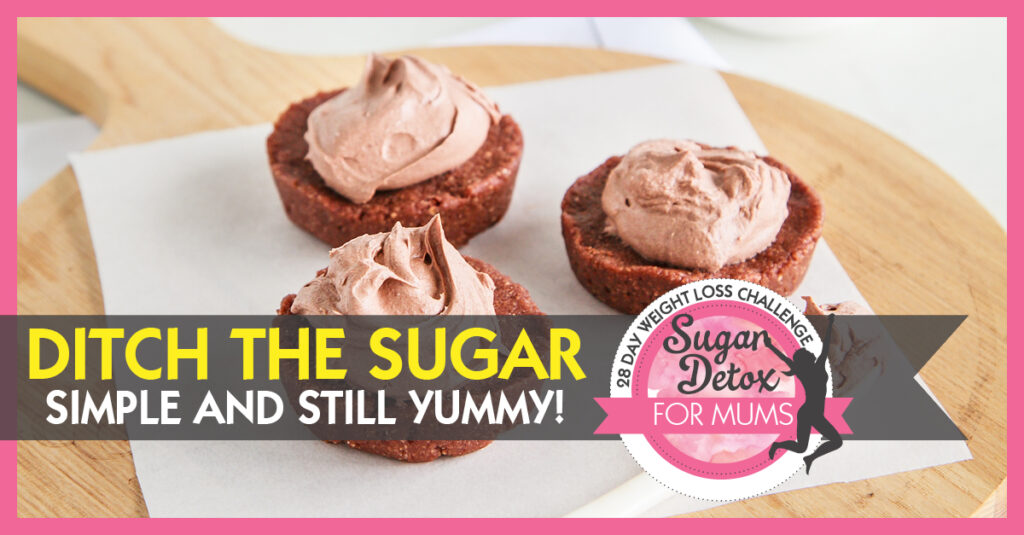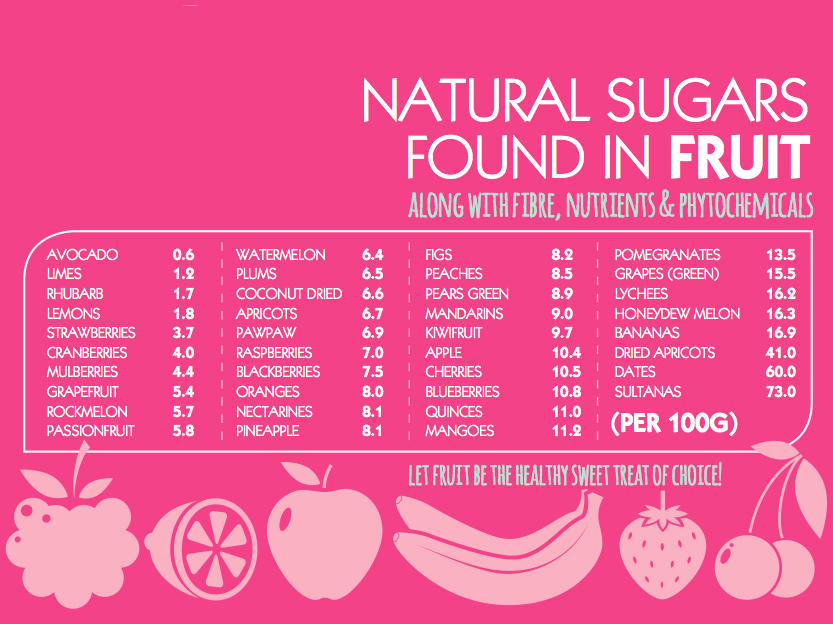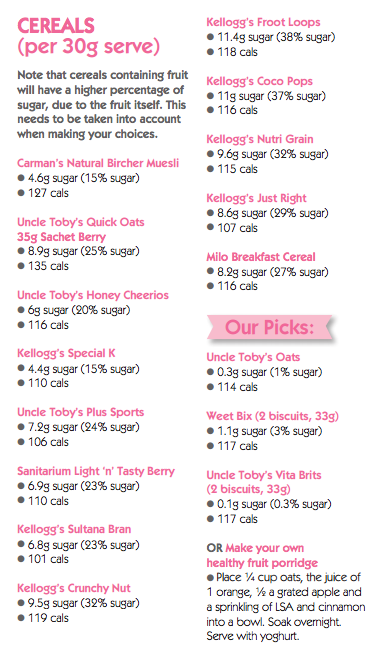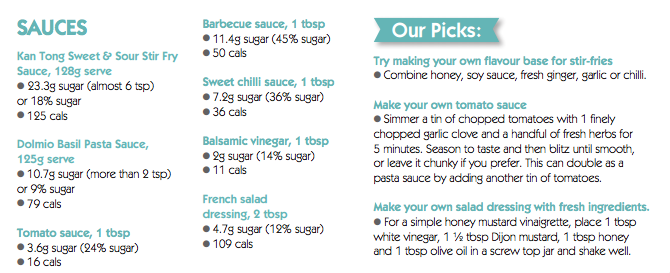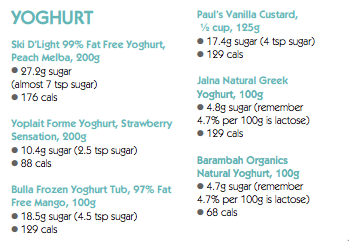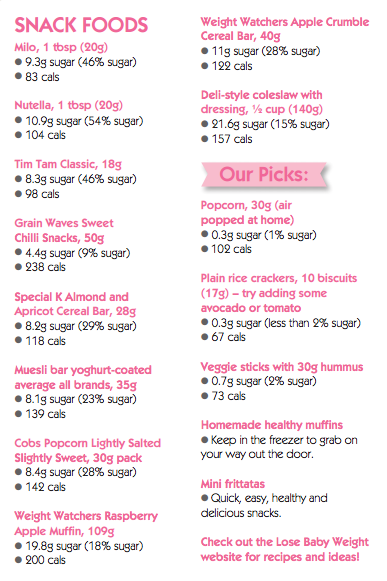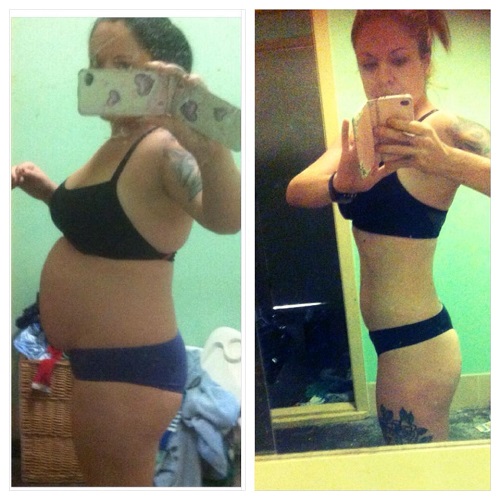
Our October 28 Day Challenge is going to be The Sugar Detox Challenge and the 40% membership discount on the 28 Day Weight Loss Challenge is NOW ON.
The SUGAR DETOX Challenge is great if you are struggling to cut out added sugars, or just want to reduce sugar in general – and especially if you need to lose tummy fat going into Summer.
The 28 Day Sugar Detox Challenge isn’t about being extreme, it’s about arming you with the facts about sugar so you can make the right decisions and make healthy eating part of your everyday life.
Get a FREE Sugar Detox recipe sampler by clicking here to see for yourself some of the yummy food you can have while on the Sugar Detox challenge
How much sugar should I have
The current recommendation from the World Health Organisation is to restrict sugar to 10% of a person’s total diet (they are considering lowering this to 5%, but this is unconfirmed as yet).
The average person’s daily energy intake is 8700kJ (2000 calories), 10% of which equates to 54 grams of sugar.
If your calorie intake is 6300KJ (1500 calories), then the maximum recommended amount of sugar would be approximately 39g
Why reduce my sugar intake?
If you are interested in having more energy, sleeping better, improving your general health, and losing weight (especially from the stomach area), reducing your sugar intake can have a dramatic impact.
Don’t worry, we’re not suggesting you start obsessively counting grams of sugar.
We simply suggest becoming more educated on where sugar might be lurking and then finding healthy and tasty alternatives.
It’s added sugar, most notably found in processed foods, or added in cooking that we want to help you reduce.
The key is to reduce your consumption of processed foods and up your real wholefood intake. You can get your sugar fix from naturally sweet foods, such as fruit, honey, vegetables and dairy products.
The challenge is not to cut out all sugar – it’s more about reducing it where you can but still enjoying it when you choose to, mindfully and in the best way to support your weight loss goals. How much sugar are you having each day?
It’s not just the sugar you might add to your tea that you need to count here. The sugar in your jam, muffin, dates, orange juice, sweets, chocolate, muesli bar, plus savoury sources you might not expect: pizza, pasta sauce, tomato sauce, dips.
It all adds up very quickly.
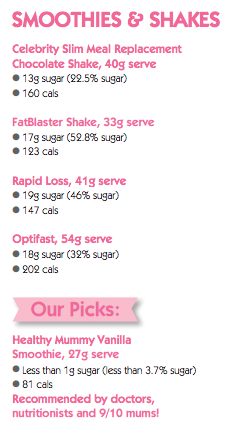
What about artificial sweeteners?
At the moment, not a lot is known about the long-term effects of sweeteners such as Splenda or Equal, although there are some worrying studies about the effect of aspartame and sucralose, the main artificial sweeteners.
See if you can retrain your taste buds to enjoy food and drinks without the added sweetness.
How do you read labels to work out the sugar content?
Check out the ‘per 100g’ column on the nutritional information panel, as this will give you the sugar as a percentage of the total product, no matter how much of it you are consuming.
As a starting point, 4g of sugar is roughly equivalent to one teaspoon of sugar.
So barbecue sauce contains 45.4g of sugar per 100g, which means that 45 per cent of the sauce is sugar.
To put it another way, in every tablespoon of barbecue sauce, there are 2 teaspoons of sugar.
Is sugar even added to healthy foods?
Sugar is in a significant number of foods that you can buy from the supermarket.
Despite having a healthy name, or sporting health claims, such as ‘contains wholegrains’, ‘fat free’, or ‘extra vitamins and minerals’, the product may still be packed with the white stuff.
It can also come with additives, preservatives, fat and salt.
What about fruit?
Which foods are lowest in sugar? Here, we clear up the confusion and give you shortcuts to living sugar free.
Sugar & Fruit
Fructose sugar is the simple monosaccharide which is predominantly found in fruit.
It has the same kilojoule content per gram of sugar as any other sugar, 16kJ per gram.
Fruit is an integral component of a balanced diet, assuming there are no intolerances.
Consuming the recommended serves of fruit per day (around 2 medium pieces) has been demonstrated extensively to support and prevent the occurrence of non-communicable diseases such as type 2 diabetes, heart disease, strokes and obesity.
The benefits of fruit include its high water content, high fibre content, high vitamin and mineral content, high antioxidant and phytochemical content, plus it’s low in fat.
Eating fruit is better than drinking it as a juice, as this delivers you the fibre of the whole fruit.
The fibre content assists in slowing the release of sugar or fructose into our bodies, which helps prolong energy levels, reduce sugar highs and lows, and sustain fullness.
Fibre also plays its own important role in gastrointestinal and heart health.
How to read labels of foods with sugar and fruit
It can be difficult to interpret the nutritional information panel and ingredients declaration on packaged foods to understand what the sugar content is, where it comes from, how much is from fruit and how much is ‘added’.
It is the added sugar that is of concern in packaged foods, not the sugar from fruit.
Most foods with fruit and less than 15g of sugar per 100g are generally okay.
Just ensure that fruit comes before the added sugar in the ingredient list, hopefully contributing a greater proportion of the overall sugar content.
How to determine the sugar content of a food with fruit.
- How many grams of sugar per 100g are there? Look at the 100g column of the nutritional information panel (NIP).
- If there is more than 5g of sugar per 100g for a food, check the ingredients.
- Is there fruit (or dairy) in there? What is the percentage of fruit? For example, if the NIP says 10g of sugar per 100g and there is 6% apple, 6g of that sugar is coming from the apple, leaving only 4g from other sources, which makes the product okay.
- If there is no fruit (or dairy) in there, look at where the sugar may be coming from. Some alternative names for sugar are: sucrose, glucose, glucose syrup, organic cane sugar, dextrose, malt, maple syrup, golden syrup, honey, inulin, HFCS.
- If there is no fruit in there and one of the sugar substances appears in the first three listed ingredients, give the product a miss.
Why is there so much fear of fructose?
There is a lot of fear about fructose as a sweetener and this is mainly due to high fructose corn syrup (HFCS), used extensively in the American food supply system.
Most Australian brands do not use HFCS.
The concerns about high fructose corn syrup are due to:
● the industrial process by which it is made
● its overuse in the American supply chain
● the question whether it is more damaging to our health to other sweeteners, and
● whether or not it is genetically modified.
There are studies which point to fructose, or more specifically high fructose corn syrup, contributing heavily to the obesity epidemic, type 2 diabetes, insulin resistance and fatty liver disease.
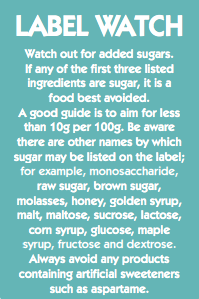
Research into the consumption of fructose in moderate amounts is limited, and in fact many of the symptoms from a hypercaloric diet of fructose or high fructose corn syrup can in fact be observed in studies which are high in fat or high in glucose.
When you consume fructose in fruit, the effect is different, as it is part of a whole food, not extrapolated as an ingredient.
If you are wanting to avoid fructose, the Healthy Mummy Smoothies are 100% fructose free and 96% sugar free. You can read all about them here
Please see our quick guide to popular foods & sugar contents below
A NOTE ABOUT DAIRY: Dairy naturally contains lactose (4.7% sugar) which is fine to consume. Anything you see above this amount per 100g is added sugar. Low-fat dairy often contains more sugar than the full-fat equivalent. When the fat is removed from a product, sugar is often added!
Get a FREE Sugar Detox recipe sampler by clicking here to see for yourself some of the yummy food you can still enjoy on the Sugar Detox challenge
Or you can join the Challenge directly here
Results from mums on the 28 Day Challenge
Mums lose an average of 4-6kg (8-13 pounds) on our 28 Day Challenge and below are some of the amazing results from mums JUST LIKE YOU who are already using the 28 Day Challenge and losing tummy fat – make the change and join them today too!
You can see lots of more results and you can join here too
Ash Loses 26kgs (57 pounds) on 7 Challenges
Ash says: “The 28 Day Challenges have changed my life. This was never a diet but a complete lifestyle change for me, and I committed to it 100% I’ve never experienced such a positive experience as I have with this plan IT WORKS. It’s perfectly put together for mums and so manageable.”
Take control of your health and get rid of those unwanted kgs for good.
Join now
You won’t regret it!
